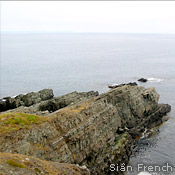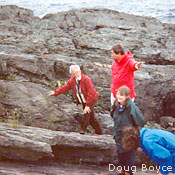Fortune Head is a rugged cape at the southwestern edge of Newfoundland’s Burin Peninsula, just 1.6 km west of the community of Fortune. The rocks in its superbly exposed low cliffs represent the geological boundary between the Precambrian Era and the Cambrian Period.

- How to get There
- Activities
- Maps
- Services
- Fees and Schedules
- Rules and Regulations
- Permits
- Other Resources
- Contact Information
Two other world-class examples of this Precambrian-Cambrian boundary stratotype are in Siberia (Russia) and Meischum (China). But in 1992 the International Union of Geological Scientists chose to designate Fortune Head as the best example in the world of this significant global stratotype. The designation made it, technically, a Global Stratotype Section and Point, or GSSP. The 2.21-km2 Fortune Head Ecological Reserve was created to protect this important interval.
The fossils in exposed rocks along the cliffs at Fortune Head are also of great interest, because the Precambrian-Cambrian boundary marks a fundamental change in Earth’s history: the first appearance of skeletal and bioturbating (sediment eating or mixing) organisms.
Roughly 540 million years ago, marine organisms began to use food more efficiently. The subsequent dramatic increase in species richness and diversity has been termed the “Cambrian explosion.” The fossils in Fortune Head Ecological Reserve represent the beginning of this explosion.
The reserve is located in the Maritime Barrens-Southeastern Barrens subregion (1.1 MB). Like other parts of the ecoregion, its landscape is characterized by exposed bedrock and extensive barrens, with tree growth often limited to protected valleys and coves.
Fortune Head was established as a provisional reserve in 1990, and given full ecological reserve status in 1992.
How to get there
The community of Fortune is about 210 km down Newfoundland’s Burin Peninsula high way (Route 210) from the Trans-Canada Highway’s Goobies turnoff. The reserve is about 1.6 km to the west of Fortune, along Route 220.
way (Route 210) from the Trans-Canada Highway’s Goobies turnoff. The reserve is about 1.6 km to the west of Fortune, along Route 220.
Access to the cliffs at Fortune Head is by foot. Access to the reserve can be gained by driving a maintained gravel road that leads to Fortune Head light station, a navigational aid operated by the Canadian Coast Guard. Visitors can walk from the lighthouse parking area to explore the reserve.
ATV use is prohibited in the reserve.
Activities
The main activity that occurs in the reserve is hiking to see the fossils-by scientists and the public. The fossils can be accessed by following the trails that leave the lighthouse parking lot. An entry permit is not required.
The Fortune Head Geology Centre, run by the Fortune Head Eco. Friends Inc., operates an interpretation centre in the community of Fortune.
During the summer, whales can be spotted from the cliffs and beach. Berry picking also occurs in season (partridgeberries, crowberries and blueberries).
Visitors making the trip are advised to:
- Dress for open-country hiking-there is a high probability you will encounter cool wind and fog
- Exercise caution near and on the coastal rocks-they can be slippery
- Read and abide by the Rules and Regulations before visiting
Hunting, fishing, and trapping are all prohibited in the reserve.
For more information and research guidelines, see Science and Research.
Services
There is no infrastructure in the reserve. However, the lighthouse and interpretation panels act as an orientation centre and are interesting places to visit. The Fortune Head Geology Centre, run by the Fortune Head Eco. Friends Inc., operates an interpretation centre in the community of Fortune.
Fees and Schedule
There are no fees involved in visiting the reserve or obtaining the various permits. Fortune Head Ecological Reserve is open year-round.
Rules and Regulations
Biodiversity protection and habitat conservation are two of the key purposes of ecological reserves, so certain rules apply within all the reserves in the province.
The public can visit most ecological reserves for educational purposes or low-impact recreational activities, such as hiking or sightseeing. In Fortune Head Ecological Reserve, hunting, fishing, and trapping are not allowed.
The following activities are strictly prohibited in all wilderness and ecological reserves:
- Disturbing, destroying, or removing plants, animals, or fossils
- Introducing plants, animals, or anything else to the reserve landscape
- Forestry, mining (including exploration), hydro development, agriculture, new roads, tracks, or building construction
- Driving off-road vehicles including all-terrain vehicles (ATVs)
Read the official reserve regulations:
- Fossil Ecological Reserve Regulations
- Fortune Head Ecological Reserve Order
- Wilderness and Ecological Reserves Act
Adobe® Acrobat® Reader software can be used for viewing PDF documents. Download Acrobat® Reader for free

